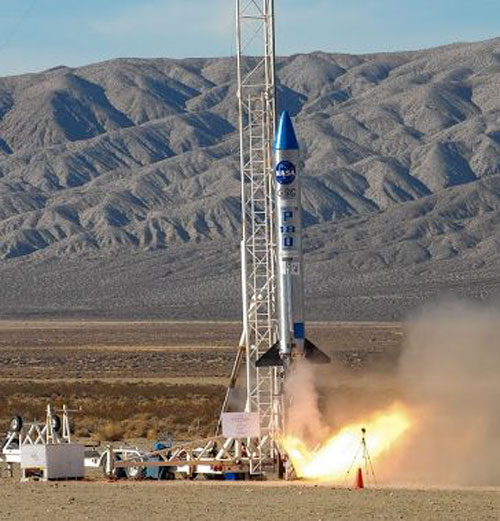.

The P-18 rocket, built by Garvey Spacecraft Corporation, is hefting a variety of payloads to the very edge of space. Image credit: Garvey Spacecraft
.
Who says that students can’t participate in the exploration of space? So far, Garvey Spacecraft Corporation’s Prospector 18 or “P-18” rocket has conducted four mission where it has launched student-built Nano and Micro satellites. While these payloads don’t reach the altitudes that those launch by Prospector’s larger cousins do – they still climb pretty far into the atmosphere.
Garvey Spacecraft Corporation is a California-based company that hefts payloads built by businesses, research firms as well as students into the very edge of space. Last December P-18 entered the “big-leagues” when it hoisted a payload for NASA’s Ames Research Center and California Polytechnic State University. This however is just the warm-up for the company’s next effort – a rocket large enough to reach orbit.
NASA funded the December launch through High Altitude Launch Service contract, with the next launch slated to occur in June of this year. During this flight, students at Merritt Island High School and California Polytechnic State University will see their CP9/StangSat sent skyward by the P-18. This particular effort is a partnership between Ames and Kennedy Space Center and will work to develop the new light-weight nanosat carrier system. Keep in mind, satellites that are launched on the P-18 are small – very small.
Each of these nanosats are essentially 4-inch squares that weigh approximately two pounds. They were designed to fit on carriers and would be shot loose once the launch vehicle had delivered them to orbit.
“Today, nanosat developers still depend on secondary ride opportunities to get to orbit,” said Garrett Skrobot of NASA’s Launch Services Program. “There are several operational issues with that approach. In response, with projects like this, we are taking the first steps with Garvey Spacecraft and other small launch vehicle developers to explore alternatives that could eventually lead to dedicated launch services that are tailored to the requirements of this market.”
Quelle: NASA
5677 Views
